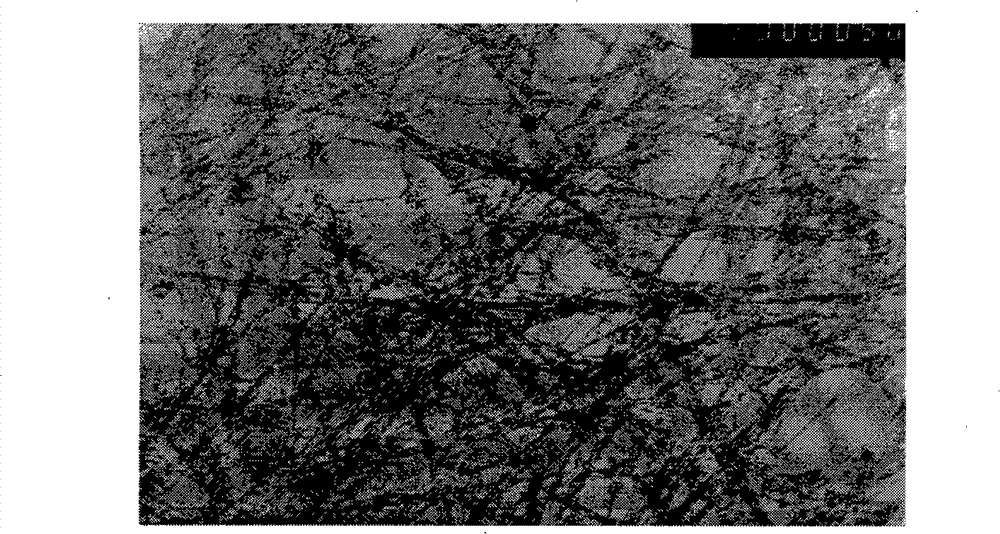Method for removing amorphous carbon in carbon nanotubes
A technology for removing carbon nanotubes and carbon nanotubes, which is applied in the field of purification of carbon nanotubes or carbon nanofibers, can solve problems such as environmental pollution, loss of carbon nanotubes, and oxidation loss of carbon nanotubes, and achieve the effect of simple operation
- Summary
- Abstract
- Description
- Claims
- Application Information
AI Technical Summary
Problems solved by technology
Method used
Image
Examples
Embodiment 1
[0022] Example 1 Weigh 5g of single-walled carbon nanotube crude product (amorphous carbon content greater than 90%), 110g of analytically pure anhydrous lithium chloride and 90g of potassium chloride, pulverize and mix in a soybean milk machine for 5 minutes, and mix the mixed material Transfer to a stainless steel reaction tube with an inner diameter of 35 mm, a height of 500 mm, and one end closed, and vibrate. The open end of the reaction tube is sealed with a rubber stopper with an air inlet pipe and an air outlet pipe, and nitrogen gas is introduced to remove the air in the reaction pipe. The stainless steel reaction tube was placed in a well-type resistance furnace, and the temperature was raised to 450°C to be constant. After 30 minutes, a molten salt solution was formed. Change the nitrogen gas to pure oxygen, control the flow rate between 10-16L / hr, and ensure that the temperature of the reaction system rises to 480°C at the maximum. After 2 hours of reaction, the re...
Embodiment 2
[0023] Example 2 Weigh 100g of crude multi-walled carbon nanotubes with an outer diameter of less than 8nm, 120g of analytically pure anhydrous lithium chloride, and 80g of potassium chloride, and grind and mix them intermittently in a soybean milk machine for 10 minutes, and operate according to the steps in Example 1. The reaction temperature is kept constant at 480° C., the maximum temperature does not exceed 510° C., and the reaction time is 4 hours. Finally, 89 g of the product was obtained with a yield of 89%. Thermal analysis data showed that the light-off temperature of the obtained small-diameter multi-walled carbon nanotubes was 587°C in air. The results of transmission electron microscopy analysis of the obtained samples were as follows: figure 2 shown.
Embodiment 3
[0024] Example 3 Weigh 50g of single-walled carbon nanotube crude product (amorphous carbon content greater than 90%), 100g of analytically pure anhydrous lithium chloride and 100g of potassium chloride and grind and mix them intermittently in a soybean milk machine for 5 minutes, according to Example 1 Step operation, the reaction temperature is constant at 550°C, the maximum temperature does not exceed 580°C, and the reaction time is 4 hours. Finally, 1.6 g of the product was obtained with a yield of 3.2%. Thermal analysis data showed that the light-off temperature of the obtained single-walled carbon nanotubes in air was 609°C. The transmission electron micrographs of the obtained single-walled carbon nanotubes are as follows: image 3 shown.
PUM
 Login to View More
Login to View More Abstract
Description
Claims
Application Information
 Login to View More
Login to View More - Generate Ideas
- Intellectual Property
- Life Sciences
- Materials
- Tech Scout
- Unparalleled Data Quality
- Higher Quality Content
- 60% Fewer Hallucinations
Browse by: Latest US Patents, China's latest patents, Technical Efficacy Thesaurus, Application Domain, Technology Topic, Popular Technical Reports.
© 2025 PatSnap. All rights reserved.Legal|Privacy policy|Modern Slavery Act Transparency Statement|Sitemap|About US| Contact US: help@patsnap.com



